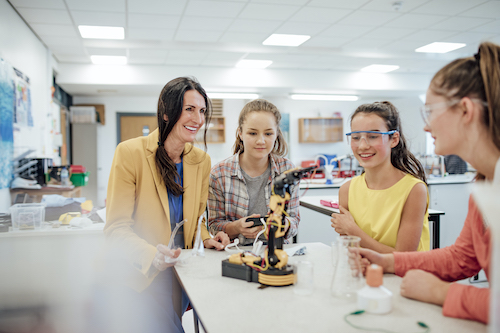This is one of the arenas in which AI stands to offer the biggest benefit. Again: the classroom is a delicate ecosystem. Every action taken by the teacher has the potential to either keep things running smoothly or send attention scattering. When, for instance, a teacher turns their back to the classroom to pull up a slideshow or configure this or that application, they risk disrupting the flow of teaching and inviting distraction amongst the students. With tools like voice-activated AI assistants, teachers can keep their attention on their students at all times, pulling up needed apps or documents using a simple spoken command.
AI is the future of work—and students need to be prepared
The nature of our economy is such that by the time today’s grade-schoolers reach working age, the jobs will be very different from those available to their parents (or even their older siblings). This has been a feature of U.S. life for centuries, but in recent decades the process has sped up, and AI stands to speed it up further. In the months since ChatGPT made its grand splash, whole new career categories have emerged—you can now make a living fashioning prompts for ChatGPT or editing ChatGPT-produced text. Looking beyond writing-based jobs, we see that AI stands to alter the fundamental nature of work, eliminating some portion of jobs devoted to rote procedural tasks and rewarding the ability to think creatively.
Inevitably, U.S. pedagogy will evolve to reflect these changes in the coming years. But for children who are in school now, those changes might come too late. For that reason, familiarizing students with AI tools today—and making AI literacy a priority in the classroom—will serve students better for tomorrow.
We have a long way to go when it comes to increasing equity in the classroom—and AI can help
In addition to affecting classroom behavioral issues, the pandemic also widened existing inequities across racial and socioeconomic lines for students. A study in PLOS of almost 300,000 students demonstrated “large inequalities in the learning loss based on parental education and parental income, on top of already existing inequalities.” This isn’t, of course, the fault of teachers, who are themselves stretched to their limit and working as hard as they can—but it is something that needs to be reckoned with.
AI has a significant role to play here, too. Teachers today are faced with a daily avalanche of rote administrative tasks, which in aggregate, prevent them from giving some students the kind of extra attention they need. AI—by simplifying and automating these repetitive tasks and granting teachers more time to focus on their students—can grant teachers the time and focus required to meet the unique needs of every single student.
Perhaps the most astonishing thing about an app like ChatGPT is that everyone who uses it knows it’s just the tip of the iceberg. We have all seen how technology has evolved over the last few decades—we know that things get exponentially better. AI is already serving the needs of teachers in some classrooms across the country, and its capabilities are likely to multiply as the years go on. Can it solve every problem in the classroom? Of course not—nor should it. The central figure in the classroom is and always will be the teacher.
Related:
6 ways AI tools will impact tutoring
Can GPT-4 and TikTok usher in a new learning frontier?
- Career and technical education needs a mental health revolution - June 16, 2023
- With Critical Race Theory spurring debate, is there hope for diversity in schools? - June 16, 2023
- Is AI the future of education? - June 15, 2023

